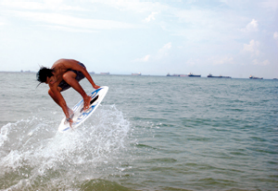SKIM'S UP!
PHOTO // Roy Lim
Yearning to surf in Singapore but foiled by the dearth of big waves on our shores? Turn your attention to skimboarding, a sport that is a cross between skateboarding and surfing, which has quietly gained a faithful following on our beaches.
You see them every weekend at the beach along East Coast Park, staring intently at the sea, waiting for that one good wave before running towards it with full gusto when it comes.
Often mistaken by beach-goers as people making futile attempts to surf in Singapore, skimboarders such as Alfian Affandi, 23, hope to set the record straight.
"It's a totally different thing. Skimboarding is done nearer to shore and it does not involve as much arm muscles as surfing, which requires you to paddle out to sea," explains Alfian, who has been skimboarding for about eight years.
"You can also skim on waves of any height, as long as it can reach the shore."
Smooth skimming
Skimboarding has been around in Singapore for more than 10 years, but you would probably see skimboarding enthusiasts only at two locations - East Coast beach and Sentosa.
Beaches at Sentosa have the unique advantage of a constant supply of artificial waves created by ferries that sail past the island.
According to Alfian, the best time to skimboard is during the monsoon season from November to March, coupled with favourable conditions such as low tides, minimal wind and no crowds.
"Strong winds make it more difficult to control the board, and it is hard to skimboard properly if you have to keep avoiding swimmers or people playing on the beach," he said.
Gearing up
Skimboards are pointed at both ends and look somewhat similar to surfboards. However, they are about half the length, half the thickness, and slightly wider. Another major difference is that skimboards have no fins on the bottom of the board used for controlling direction.
This means they are less stable and require a lot of practice to handle. However, it also means there is more allowance for manoeuvrability and types of stunts that can be executed.
The myriad of stunts that can be done is bound merely by one's creativity - you can also derive stunts from your skateboarding or wakeboarding experience. Some examples include the Shove-it, 360 Shove-it, Kick-flip, the Ollie and the Rodeo.
Skimboarders opt largely for lighter carbon fibre or fibre glass boards these days instead of the denser wooden ones. A beginner's wooden board can set you back by more than $200 whereas a carbon fibre one can cost about $700.
Traction pads and arch bars are some of the other essential accessories needed to provide sufficient friction for your feet as you stand on the board.
Barring sharp rocks and broken glass on the sand, the sport is quite safe. If you fall, aim to land in the water. Always be aware of where your board flies to as it may hit you when you fall.
The thrill of it all
The sport is suitable for all ages, but young skimboarders have an edge since there's a better chance of them progressing further as they get older.
Shabree Kamalluddin, 16, picked up the sport about a year ago from his brother and has since become addicted to the adrenaline rush he draws from it.
"It's really fun and exciting and you need to use a lot of energy and stamina, as well as body movement and balance, to do it well," he said
"The most difficult part is balance; putting your foot at the right place. It took close to four months for me to skim properly on a wave!"
Fellow skimboarder 2SG Benjamin Teo, an Air Defence System Specialist, relishes the challenge of pitting his skills against Mother Nature.
"You are fighting against the waves and when you eventually manage to ride it, the feeling is great!" he said.
"It is all about perseverance as you learn to drop the board and get on it the right way. It is not easy to get the timing and balance right. And even to hit the right momentum, you have to anticipate the waves and the only way to do that is through practice and watching others."
Any advice for newbies to the sport?
"Don't be afraid, don't let fear hold you back and just go for it!" he said earnestly.
Like a mantra to recite over and over in your head, these are the three magic words that sum up the art of skimboarding for the novice and expert alike:
First, with your skimboard in hand, observe the wave patterns and wait for a suitable wave to come into shore and start running towards it before it breaks on the shore.
When the white wash of the preceding wave appears, drop your board and jump on it as quickly as possible, one leg placed in front of the other on the board. Keep your weight centered over the board and keep the board pointed towards the ocean.
Lastly, slide effortlessly on the wet sand and onto the waves. When the skimboard meets the water, your weight should be on your back foot so the nose of the board glides up over the water.
Depending on whether the rider has enough speed, balance and ability to turn, the rider can do various manoeuvres while skimming off the wave and riding towards the shore. Unlike surfing, skimboarding allows for the ability to spin, greatly increasing its possibilities.
With his fellow skimboarders zipping about on the waves in carbon fibre and fibre glass boards, Hazlan 'Shaper' Saad, 28, is nonchalant and almost stoic in his preference for long-forgotten wooden boards - ones that are painstakingly handmade by himself, no less.
Hazlan has been crafting boards from scratch ever since he picked up the sport seven years ago. Equipped with nothing more but a saw and sandpaper, he transforms pieces of marine plywood into skimboards that can conquer the onrushing waves.
"The best lines you can make are those that you touch and feel with your hands, so that's all I use to shape the board," said Hazlan.
"The most difficult part is getting the 'rocker' (slant of the board) right, for it to go up exactly where you want. It's mainly trial and error when I make them."
With the level of difficulty it entails, it is no wonder each personalised board takes him up to three months to complete. Hazlan has made over 20 boards so far, both for his own use and as gifts for his close friends.
The wooden boards can last for two to four years, depending on frequency of usage and what Hazlan likes about them is how hardy and relatively maintenance-free they are.
"With the fibre glass boards, you will get 'dings' (dents in the board) when the board hits the rocks. Serious 'dings' and those that are left unattended may cause the board to split. This is unavoidable unless you make the sea rock-free - which is impossible," he said.
"You don't have to worry so much if it is a wooden board. However, wood does not float as well on water as it is much heavier. To me, that just means you have to be a lot more skilful to reach the same level as with the synthetic boards."
Hazlan was quick to add, however, that it is all about having fun and it doesn't really matter which board you use.
There's just an undeniable tinge of nostalgic charm to see him riding on the waves, on his labour of love.










